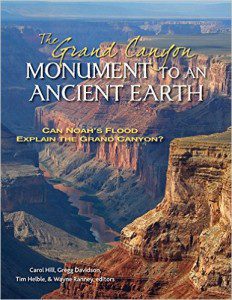(Image from Wikipedia: credit)
The final section of the new book The Grand Canyon, Monument to an Ancient Earth: Can Noah’s Flood Explain the Grand Canyon? summarizes the evidence for the Grand Canyon as a monument to an ancient earth and asks if the differing conclusions reached by mainstream geologists and flood geologists is just a matter of worldview. Starting at the bottom of the canyon and hiking up one of the routes to the rim (the authors use the South Kaibab trail) is a trek through time. On top of the lowest igneous and metamorphic rock are multiple layers of sedimentary rock testifying to periods where the land was well underwater, under a shallow sea, dry land with rivers cut into the ground, underwater again, and sand desert. The fossils and trace fossils are in a progression from simpler to more complex life forms (not smaller to larger). Marine and terrestrial fossils are segregated into layers . “The fact that terrestrial and marine fossils are not found intermingled within the same layers is clear evidence of distinct intervals of time when the region was sometimes above seal level and other times below it.” (p. 200-201) This is not consistent with a flood model that requires all layers to be deposited in the waters of the flood.
Gregg Davidson and Wayne Ranney sum up:
The canyons many layers, structures, and faults certainly represent powerful forces at work, but each is easily accounted for by normal earth processes – some slow and some fast – but all normal. More importantly, the explanations for each individual layer or feature fit together into a larger story of rising and falling sea levels, and of slowly shifting tectonic plates lifting and lowering the crust. Fossils encountered along the trail in the canyon, and found around the world, communicate a consistent story as well – a story that makes sense only if the types of organisms present varied considerably at different times in the Earth’s history. The fact that not a single fossil bird, dinosaur, mammal, or flowering plant can be found anywhere along this 7-mile hike is of great significance.
Flood geology arguments often have a ring of plausibility to them when they are applied to one layer or feature in isolation, but there is no way to piece together all the individual explanations into a coherent whole.
…
The immense record of fossil life is said to be evidence of a global flood that swept across entire continents, yet that flood somehow failed to capture a single mouse, seagull, whale, frog, tulip, or lobster in the entire Grand Canyon sequence.
The conventional geologic understanding of the Grand Canyon is not just better than the flood geology view. The conventional model works; the flood model does not. (p. 204-205)
This book is a labor of love from a number of geologists, paleontologists, and biologists. Most of them Christians, including professors from both Wheaton College and Calvin College. They are responding to a need in the church to explain why it is simply unreasonable to view the Grand Canyon layers as deposited in a single global flood of approximately one year duration, or even in a few thousand years from creation week to the appearance of human settlements on the rim. This book is intended as a gift for the church.
 Does it matter? It is important that Christians, and especially church leaders and teachers, realize that the evidence for an ancient earth is impressive and persuasive. In the final chapter the authors (and the chapter is attributed to all of them) address the claim that the difference between the Young Earth flood geology view and the conventional old earth view is “because of the biblical or humanistic “glasses” each person wears.” (p. 207) Both are doing good “science” but conclusions are driven by worldview. But this isn’t true. Most of the authors of this book are strong Christians who take the Bible very seriously. I have had the opportunity to meet and talk with a number of them (Gregg Davidson, Joel Duff, Stephen Moshier, Ralph Stearley, and Ken Wolgemuth). These men are not lukewarm Christians dedicated to a humanistic approach to life or the world around us.
Does it matter? It is important that Christians, and especially church leaders and teachers, realize that the evidence for an ancient earth is impressive and persuasive. In the final chapter the authors (and the chapter is attributed to all of them) address the claim that the difference between the Young Earth flood geology view and the conventional old earth view is “because of the biblical or humanistic “glasses” each person wears.” (p. 207) Both are doing good “science” but conclusions are driven by worldview. But this isn’t true. Most of the authors of this book are strong Christians who take the Bible very seriously. I have had the opportunity to meet and talk with a number of them (Gregg Davidson, Joel Duff, Stephen Moshier, Ralph Stearley, and Ken Wolgemuth). These men are not lukewarm Christians dedicated to a humanistic approach to life or the world around us.
Contrary to the doctrine of flood geologists, the worldview of flood geology is not distinguished from other worldviews by its adherence to the scriptures found in the Bible. Rather, its distinguishing characteristic is adherence to a particular way of interpreting select passages within the Bible – accepted as fact, without considering any conflicting evidence within or outside the Bible. As a result, all data from nature must be force-fit into the accepted-truth model, no matter how convoluted the resulting story may become. (p. 208)
In fact, it is necessary to postulate all kinds of phenomena that are not testified to in the Bible in any way, shape, or form. The Bible gives the impression that the land was largely the same both before and after the flood, that the kinds of plants and animals present were the same both before and after the flood, that the laws of nature (although the ancient audience would have seen them as laws of God) were the same both before and after the flood. The claim that the flood accounts for plate tectonics, the fossil record, and the Grand Canyon can only be supported by surmising massive changes in physical laws.
Scientific young earth creationism, and especially flood geology, simply cannot account for the evidence. Claiming that it does, that science (done properly) supports a young earth and making this a cornerstone of Christian faith will (and does) drive many people away from the faith altogether … if they already know, or when they dig into the science for one reason or another.
One can postulate a mature creation some 6000 years ago, with the evidence for great age a part of the original creation for reasons known only to God. I think there are theological problems with this view, but it sidesteps most of the scientific problems (human population remains a problem). Flood geology and scientific creationism go nowhere.
This is a fascinating book, with marvelous illustrations. I recommend it to anyone who wishes to dig deeper into the evidence for an ancient earth. It matters because, as the authors conclude their book: “Truth always matters.” (p. 209)
I pray for the day when this book is unnecessary, and the authors can write a second edition providing the scientific description of the Grand Canyon as a monument to an ancient earth and an awesome God without the need to discuss flood geology.
If you wish to contact me directly you may do so at rjs4mail[at]att.net
If interested you can subscribe to a full text feed of my posts at Musings on Science and Theology.
















